The muscle acti Study guides, Class notes & Summaries
Looking for the best study guides, study notes and summaries about The muscle acti? On this page you'll find 29 study documents about The muscle acti.
All 29 results
Sort by
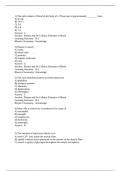
-
BMEN 1208 mockexam10_24_16 QUESTIONS WITH 100% CORRECT ANSWERS/ A+ GRADE
- Exam (elaborations) • 29 pages • 2023
-
- $10.49
- + learn more
1) The total volume of blood in the body of a 70-kg man is approximately ________ liters. A) 25-30 B) 10-15 C) 5-6 D) 2-4 E) 1-2 Answer: C Section: Plasma and the Cellular Elements of Blood Learning Outcome: 16.1 Bloom's Taxonomy: Knowledge 2) Plasma is mostly A) water. B) blood cells. C) proteins. D) organic molecules. E) ions. Answer: A Section: Plasma and the Cellular Elements of Blood Learning Outcome: 16.1 Bloom's Taxonomy: Knowledge 3) The most abundant proteins in bl...
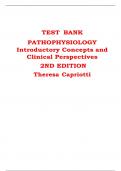
-
TEST BANK PATHOPHYSIOLOGY Introductory Concepts and Clinical Perspectives 2ND EDITION Theresa Capriotti
- Exam (elaborations) • 811 pages • 2024
- Available in package deal
-
- $17.99
- + learn more
Which statement regarding the sodium-potassium pump is correct? 1. The cell’s plasma membrane is more soluble to sodium ions than potassium ions. 2. The concentration of sodium ions should be higher inside the cell compartment. 3. The concentration of potassium ions should be higher outside the cell compartment. 4. The active transport involves pumping out three sodium ions and pumping in two potassium ions. 2. What is the process in which glucose is used to create energy? 1. Autolysis ...
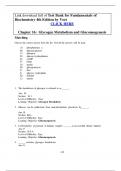
-
Test Bank for Fundamentals of Biochemistry, Voet 4th Edition Chapter 16: Glycogen Metabolism and Gluconeogenesis
- Exam (elaborations) • 17 pages • 2024
-
- $9.49
- + learn more
Matching Choose the correct answer from the list. Not all the answers will be used. A) phosphorylase a B) gluconeogenesis C) glucagon D) glucose-6-phosphatase E) cAMP F) biotin G) insulin H) glycogenolysis I) liver J) glucose-1-phosphate K) dolichol L) muscle 1. The breakdown of glycogen is referred to as ______. Ans: H Section: 16.1 Level of Difficulty: Easy Learning Objective: Glycogen Breakdown 2. Glucose can be synthesized from noncarbohydrate precursors by______. Ans: B ...
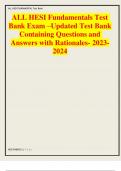
-
All HESI FUNDAMENTAL EXAM TEST BANK UPDATED VERSION WITH RATIONALE CONTAINING QUESTIONS AND ANSWERS WITH RATIONALES, 2023-2024...
- Exam (elaborations) • 187 pages • 2023
- Available in package deal
-
- $10.99
- + learn more
Multiple Choices Question 1 An elderly client wi a fractured left hip is on strict bedrest. Which nursing measure is essential to the client's nursi g care A. Massage any r dd ned reas for at least e minutes. B. Encourage act ve r nge of motion xercises on ext mities. C. Position the client laterally, prone, and dorsally in seq ce. D. Gently lift the client when movi g into a desired position - To void shearing forces when repositioning, the clien sho be lifte gent...
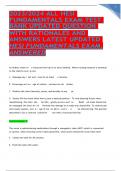
-
2023/2024 HESI BANK FUNDAMENTALS EXAM TESTS UPDATED QUESTIONS
- Exam (elaborations) • 186 pages • 2024
-
Available in package deal
-
- $13.49
- + learn more
An elderly client wi a fractured left hip is on strict bedrest. Which nursing measure is essential to the client's nursi g care A. Massage any r dd ned reas for at least e minutes. B. Encourage act ve r nge of motion xercises on ext mities. C. Position the client laterally, prone, and dorsally in seq ce. D. Gently lift the client when movi g into a desired position - To void shearing forces when repositioning, the clien sho be lifte gently across a surf ce Redd ed areas should not be mas...
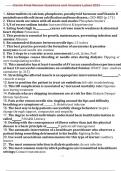
-
Davita Final Review Questions and Answers Latest 2023
- Exam (elaborations) • 13 pages • 2023
-
Available in package deal
-
- $12.99
- + learn more
Davita Final Review Questions and Answers Latest 2023 1. Abnormalities in calcium, phosphorus, parathyroid hormone and Vitamin D metabolism with soft tissue calcification and bone disease.: CKD-MBD (p. 171) 2. These meds are taken with all meals and snacks: Phosphate binders 3. S/S of excess sodium intake: Increased thirst & hypertension 4. Eating foods high in causes extreme muscle weakness & abnormal heart rhythm: Potassium 5. This protein is essential for growth, maintenance, preventing ...
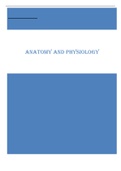
-
HESI A2 ANATOMY AND PHYSIOLOGY-CHRISJAY FILES (1)
- Exam (elaborations) • 83 pages • 2023
-
- $13.99
- + learn more
ANATOMY AND PHYSIOLOGY A&P FILES ANATOMY AND PHYSIOLOGY 1. Skin responsible for finger prints? Dermal papillase Markel cells Amectors pili Sudoriferous gland 2. What type of synovia joint is the elbow? Pivot Hinge Ball and socket Toddle 3. Where is blood produced in infants after birth? Heart chamber Red bone marrow 4. What structure is a ball and socket joint? Elbow Ankle Shoulder Knee 5. What are macromolecules genetic code carried on? Nucleotide Chromosomes DNA RNA ...
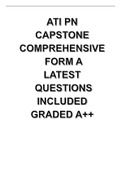
-
ATI PN CAPSTONE COMPREHENSIVE FORM A LATEST QUESTIONS INCLUDED GRADED A++
- Exam (elaborations) • 84 pages • 2022
-
Available in package deal
-
- $20.49
- + learn more
1 / 51 1 1. A nurse is teaching a client who has a new prescription for metformin extended release tablets. Which of the following statements by the client indicates an understanding of the teaching? I will avoid crushing this medication I'll switch to a lactosefree formula 2. A nurse is assessing a client who is receiving enteral feeding via an NG tube. The client has developed hyperosmolar dehydration. Which of the following ac- tions should the nurse take when administering the cl...
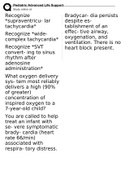
-
AHA Pediatric Advanced Life Support 2023 Exam / PALS 2023 Exam (answered)
- Exam (elaborations) • 111 pages • 2023
-
- $15.99
- + learn more
Recognize *supraventricu- lar tachycardia* Recognize *wide-complex tachycardia* Recognize *SVT convert- ing to sinus rhythm after adenosine administration* What oxygen delivery sys- tem most reliably delivers a high (90% of greater) concentration of inspired oxygen to a 7-year-old child? You are called to help treat an infant with se- vere symptomatic brady- cardia (heart rate 66/min) associated with respira- tory distress. Bradycar- dia persists despite es- tablishment of an effec- tive airway,...

-
1. Identify the muscle in the picture above, specified by the lab instructor, and list its innervation. Biceps Femoris - Common fibular nerve (peroneal) 2. Identify the muscle in the picture above, specified by the lab instructor, and its actions. (D
- Exam (elaborations) • 16 pages • 2023
-
- $17.99
- + learn more
1. Identify the muscle in the picture above, specified by the lab instructor, and list its innervation. Biceps Femoris - Common fibular nerve (peroneal) 2. Identify the muscle in the picture above, specified by the lab instructor, and its actions. (Dissection of the lower leg) Tibialis Anterior - Dorsiflexion, inversion of foot 3. Extensor Digitorum Longus: (mark all that apply) a. Extends toes b. Plantarflexes ankle c. Innervated by peroneal nerve a,c 4. Soleus: (...

How did he do that? By selling his study resources on Stuvia. Try it yourself! Discover all about earning on Stuvia


